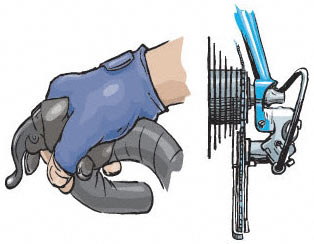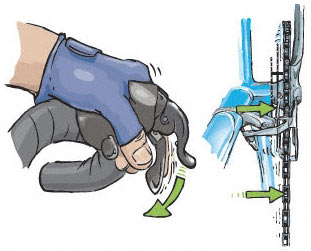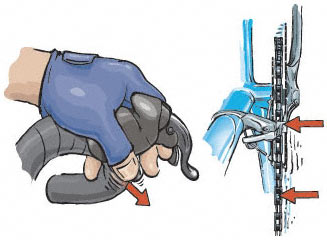How To Shift Campagnolo Ergopower!
|
Shifting (also called changing gears) is the secret to riding comfortably and efficiently whether you're climbing and descending, sailing along flat stretches with
|
||
| Shifting the right lever (see the 6 illustrations below) controls the rear derailleur and moves the chain onto the different cogs in the rear. Notice that there are 2 levers you operate to shift, the main lever that's just behind the brake lever and that you push with your fingers, and a secondary button-like lever located on the inside of the body of the lever at the top, which you push with your thumb. You move these levers separately, pushing the main lever inward toward the center of the bike and the secondary lever down with your thumb as follows: |
||
| When you're just riding along, your hand can rest on the top of the lever (called the "brake hood") or on the lower part of the handlebars. In both positions it's easy to reach and operate the 2 shift levers, the main lever just behind the brake lever and the button-like top lever near your thumb. |  |
|
| When you feel like it's too hard to pedal and want to shift into an easier gear, you push inward on the main lever. It clicks with each push and this moves the rear derailleur, which in turn shifts the chain onto the next larger rear cog making it easier to pedal. You can click the lever again to shift into an easier gear, and so on. You can also push farther on the lever to shift up more than one cog at a time if you like, |
 |
|
| When you feel like it's too easy to pedal and you'd like a harder gear, you push the button-like lever on the inside top of the lever down with your thumb. It clicks with each push and this moves the rear derailleur, which in turn shifts the chain onto the next smaller rear cog making it harder to pedal. You can repeat as needed or you can push the lever further to shift down several cogs at once. |  |
|
| Shifting the left lever (see the 6 illustrations below) controls the front derailleur and moves the chain onto the different chainrings. Notice that there are 2 levers you operate to shift, the main lever that's just behind the brake lever and that you push with your fingers, and a secondary button-like lever located on the inside of the body of the lever at the top, which you push with your thumb. You move these levers separately, pushing the main lever inward toward the center of the bike and the secondary lever down with your thumb as follows: |
||
| The left lever operates like the right lever, with 2 levers, a main one pushed with your fingers and a secondary button-like lever located on the inside of the lever near the top and pushed with your thumb. Because there are only 2 or 3 chainrings, and they vary in size so much, the levers must be pushed a little further than the right lever to complete a shift. Like the right lever, you can shift with your hand resting on the top of the lever and when you're on the lower part of the bars, too. |  |
|
| When you need to make it a lot harder to pedal (as you will when you crest a hill and start going a lot faster down the other side), you push inward on the large lever to shift the chain onto a larger chainring making it a good bit harder to pedal. You can do this in a single long sweep of the lever, or two or more shorter motions. |  |
|
| When you need to make it a lot easier to pedal (as you will when you come to uphills), pushing the button-like lever down with your thumb shifts the front derailleur in the opposite direction and moves the chain onto a smaller chainring, which makes it a lot easier to pedal the bike. |  |
|
|
That's all there is to it! Now, with a little practice you'll be shifting up a storm and having more fun than ever. Remember, if you have any questions about shifting or anything else cycling, just drop by. We're always happy to help! And, please keep in mind, that if your derailleurs are out of adjustment and your bicycle isn't shifting properly any more we're happy to help you with the problem and get your bike shifting like a champ again. Just let us know. Thanks! |
||

 glorious tailwinds, pedaling purely for pleasure or going for gold. And today bicycles are easier, more efficient and more fun to shift than ever thanks to easy-to-operate and convenient shift levers integrated into the brake levers (or right next to them), and improved shifting components, too. These amazing shifting systems let you change gears almost as fast as the thought crosses your mind. And you never even need to remove your hands from the handlebars!
glorious tailwinds, pedaling purely for pleasure or going for gold. And today bicycles are easier, more efficient and more fun to shift than ever thanks to easy-to-operate and convenient shift levers integrated into the brake levers (or right next to them), and improved shifting components, too. These amazing shifting systems let you change gears almost as fast as the thought crosses your mind. And you never even need to remove your hands from the handlebars!